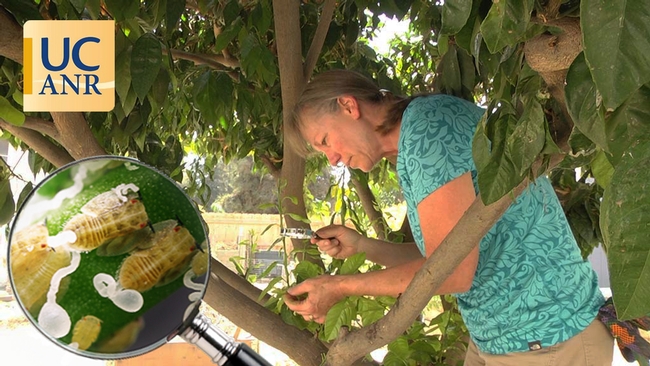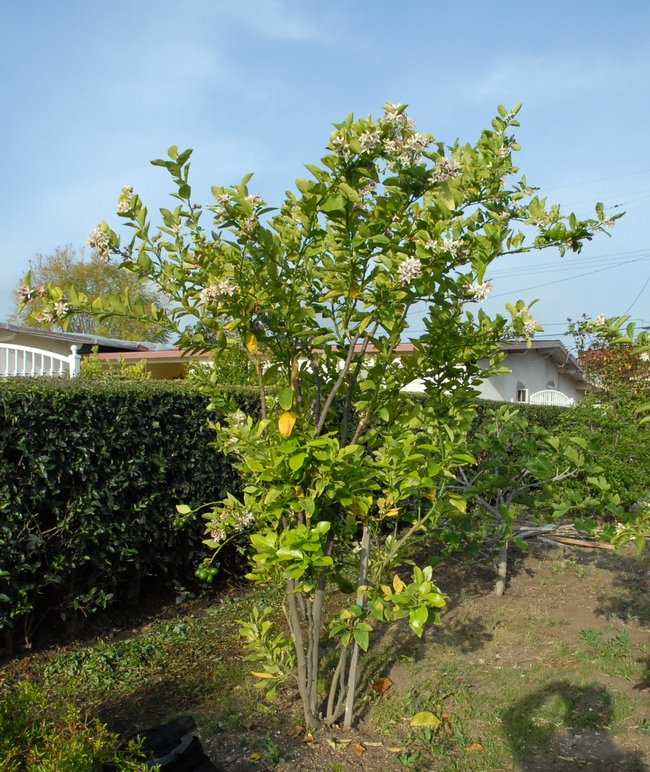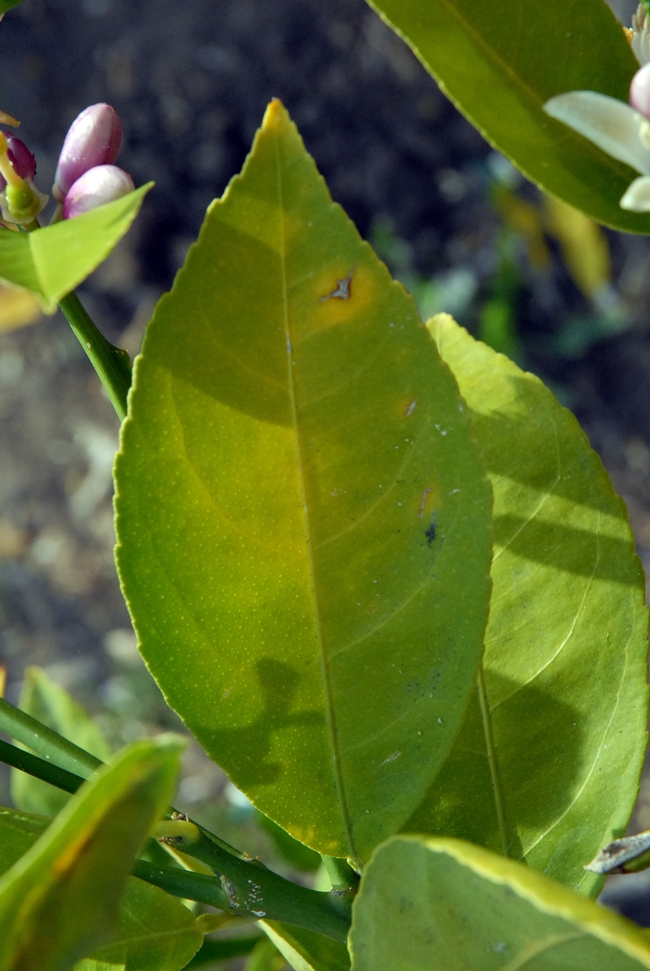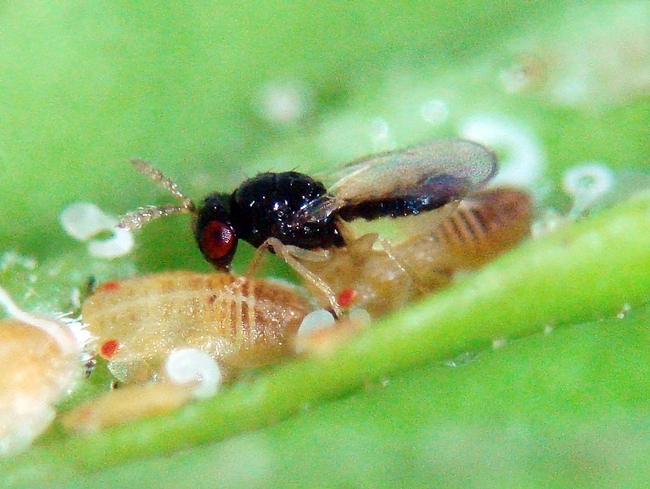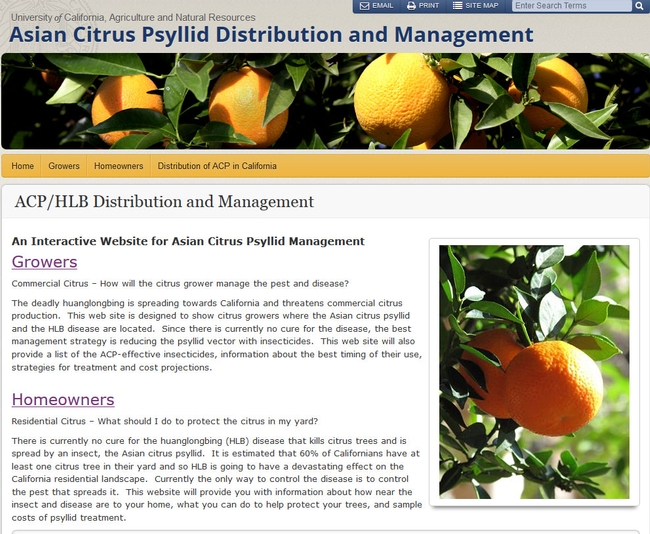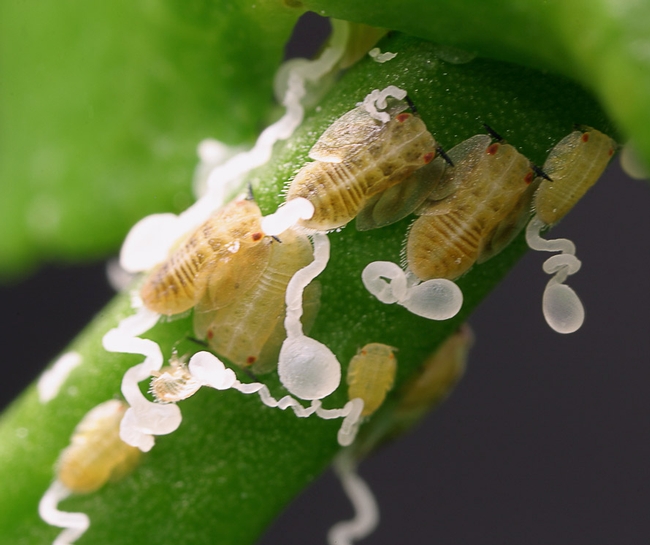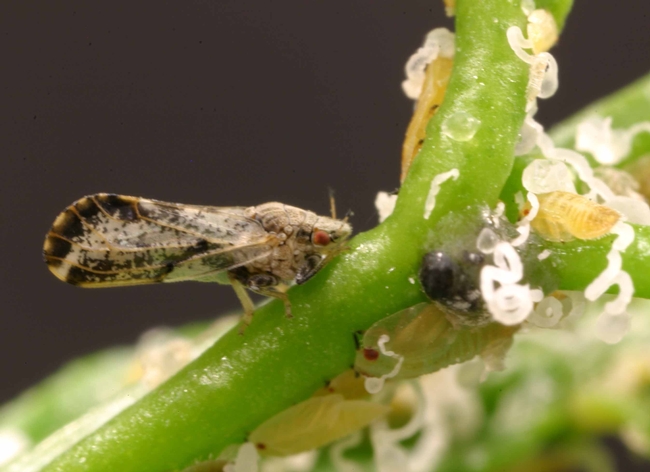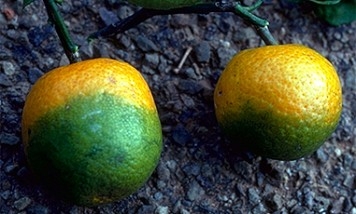Posts Tagged: Huanglongbing
Spring in California is time to inspect citrus trees for Asian citrus psyllid
A tell-tale sign of spring in California is a flush of new leaf growth on citrus trees. Because the feathery light green leaves are particularly attractive to Asian citrus psyllids (ACP), the leaves' emergence marks a critical time to determine whether the pest has infested trees.
“We encourage home citrus growers and farmers to go out with a magnifying glass or hand lens and look closely at the new growth,” said Beth Grafton-Cardwell, UC Agriculture and Natural Resources (UC ANR) citrus entomologist. “Look for the various stages of the psyllid – small yellow eggs, sesame-seed sized yellow ACP young with curly white tubules, or aphid-like adults that perch with their hind quarters angled up.”
Pictures of the Asian citrus psyllids and its life stages are on the UC ANR website at http://ucanr.edu/acp. If you find signs of the insect, call the California Food and Agriculture (CDFA) Exotic Pest Hotline at (800) 491-1899.
Asian citrus psyllids are feared because they can spread huanglongbing (HLB) disease, an incurable condition that first causes yellow mottling on the leaves and later sour, misshapen fruit before killing the tree. ACP, native of Pakistan, Afghanistan and other tropical and subtropics regions of Asian, was first detected in California in 2008. Everywhere Asian citrus psyllids have appeared – including Florida and Texas – the pests have found and spread the disease. A few HLB-infected trees have been located in urban Los Angeles County. They were quickly removed by CDFA officials.
“In California, we are working hard to keep the population of ACP as low as possible until researchers can find a cure for the disease,” Grafton-Cardwell said. “We need the help of citrus farmers and home gardeners.”
Grafton-Cardwell has spearheaded the development of the UC ANR ACP website for citrus growers and citrus homeowners that provides help in finding the pest and what to do next. The site has an interactive map tool to locate residences and farms that are in areas where the psyllid has already become established, and areas where they are posing a risk to the citrus industry and must be aggressively treated by county officials.
The website outlines biological control efforts that are underway, and directions for insecticidal control, if it is needed. An online calculator on the website allows farmers and homeowners to determine their potential costs for using insecticides.
There are additional measures that can be taken to support the fight against ACP and HLB in California.
- When planting new citrus trees, only purchase the trees from reputable nurseries. Do not accept tree cuttings or budwood from friends or relatives.
- After pruning or cutting down a citrus tree, dry out the green waste or double bag it to make sure that live psyllids won't ride into another region on the foliage.
- Control ants in and near citrus trees with bait stations. Scientists have released natural enemies of ACP in Southern California to help keep the pest in check. However, ants will protect ACP from the natural enemies. Ants favor the presence of ACP because the psyllid produces honeydew, a food source for ants.
- Learn more about the Asian citrus psyllid and huanglongbing disease by reading the detailed pest note on UC ANR's Statewide Integrated Pest Management website.
- Assist in the control of ACP by supporting CDFA insecticide treatments of your citrus or treating the citrus yourself when psyllids are present.
- Support the removal of HLB-infected trees.
UC ANR scientists urge citrus farmers and backyard growers to be vigilant in face of new disease find
Now that two additional backyard citrus trees in Southern California were found to be infected with the bacterium that causes Huanglongbing (HLB) disease, UC Agriculture and Natural Resources (UC ANR) Cooperative Extension advisors and specialists are encouraging all citrus owners to monitor for disease symptoms and report trees suspected to be infected with HLB to the California Department of Food and Agriculture (CDFA) hotline, (800) 491-1899.
This month, a lime tree and a kumquat tree with HLB were identified in residential areas of the San Gabriel Valley. In March 2012, an infected multi-grafted citrus was found in a Hacienda Heights backyard.
“So far, the bacterium that causes HLB has been found infecting only three trees, which have all been destroyed,” said Beth Grafton-Cardwell, UC ANR Cooperative Extension citrus entomology specialist. “However, it is highly likely there are other infected trees in California. It will be critical for all Californians to assist with efforts to reduce psyllids and detect and remove infected trees to prevent this disease from devastating California citrus.”
An early symptom of Huanglongbing disease is yellowing of leaves on an individual limb or one sector of the tree's canopy, according to a UC ANR Integrated Pest Management Program Pest Note. Leaves that turn yellow from HLB will show an asymmetrical pattern of blotchy yellowing or mottling of the leaves. The Pest Note includes color pictures and detailed symptom descriptions.
HLB disease is spread from tree to tree by Asian citrus psyllid, an invasive insect first identified in California in 2008. ACP has become established in many Southern California communities and is seen occasionally in the state's San Joaquin Valley and Central Coast commercial citrus production areas. Locations where ACP are found are quarantined by CDFA. No untreated or unprocessed citrus fruit and no citrus trees may be moved from these areas. UC ANR maintains an online map that delineates the quarantined locations. The map also shows the area quarantined because of the recent HLB find.
Once a tree is infected with the bacterium that causes HLB, there is no cure. To prevent HLB infections, citrus owners in areas where Asian citrus psyllids are found may wish to treat their trees with insecticides.
“We believe about 60 percent of Californians have at least one citrus tree in their yard, so HLB could have a devastating effect on the California residential landscape,” Grafton-Cardwell said. “There are safe and effective ways to reduce the ACP population, which reduces the chances of losing a tree to HLB.”
Grafton-Cardwell developed a website for farmers and residents with detailed information on managing Asian citrus psyllid. In some urban areas, a natural enemy of ACP, Tamarixia radiata, has been released. In those areas, Grafton-Cardwell recommends the use of “soft” insecticides that will reduce the number of psyllids and allow the Tamarixia to control the rest.
If Tamarixia are not in the area, the website gives information on broad spectrum insecticides to reduce the number of psyllids. The website provides the names of the pesticides, their costs, the duration of control and the effectiveness of the pesticides against ACP.
To help California residents and commercial citrus growers deal with the ACP and HLB citrus threats, UC ANR, UC Davis and UC Riverside scientists are conducting research on a number of possible solutions.
For example, Abhaya Dandekar, professor in the Department of Plant Sciences at UC Davis, and his colleagues are studying gene fusion, which fuses two immunosuppressive genes that attack HLB in different ways to make the plant more effective at fighting the disease.
Mikeal Roose, a professor in the Department of Botany and Plant Sciences at UC Riverside, is working with researchers in Florida to sequence a rootstock that has some natural resistance to HLB and locate the gene or genes that cause HLB resistance.
Mark Hoddle, UC ANR Cooperative Extension biocontrol specialist at UC Riverside, has identified a second natural enemy of ACP from the Punjab, Pakistan. (The first one was Tamarixia radiata.) Populations of Diaphorencyrtus aligarhensis have also been released in urban areas and Hoddle is monitoring the insect's ability to attack ACP.
Because it is important to remove trees infected with HLB as soon as possible to reduce spread, UC scientists are also studying ways to identify trees with the disease before visual symptoms occur.
For example, Hailing Jin, professor in the Department of Plant Pathology at UC Riverside, has identified small RNAs that are induced by the bacterium that causes HLB and could be used for early diagnosis.
Carolyn Slupsky, professor in the Department of Food Science and Technology at UC Davis, has identified metabolites that change in concentration when citrus is infected with the bacterium that causes HLB. She is working with the Citrus Research Board (CRB), CDFA, Texas A&M, and USDA to validate her results and determine how quickly the disease may be detected once the tree has been exposed to the pathogen. She is also part of a USDA collaborative grant to study the vector that transmits the disease to help find ways to stop transmission.
Wenbo Ma, professor in the Department of Plant Pathology Microbiology at UC Riverside, has developed antibodies against proteins secreted by the HLB pathogen – revealing whether the plant is infected. These antibodies have been evaluated in California, Florida and Texas for HLB detection.
An initiative to manage endemic and invasive pests and diseases is part of UC Agriculture and Natural Resources Strategic Vision 2025.
This story is also available in Spanish.
Author: Jeannette Warnert
New resource for growers and homeowners waging Asian citrus psyllid battle
Detailed and scientifically sound guidelines for treating farm- and home-grown citrus infested with Asian citrus psyllid are available on a new UC Cooperative Extension website, http://ucanr.edu/sites/acp.
The site’s launch coincides with the announcement last month by the California Department of Food and Agriculture that six more psyllids were found in three Tulare County yellow sticky traps. In 2012, three psyllids were found on two traps and an eradication program ensued.
The new website was developed by Beth Grafton-Cardwell and Matt Daugherty, UCCE specialists in the Department of Entomology at UC Riverside, Karen Jetter, economist with the UC Agricultural Issues Center, and Robert Johnson programmer with the UC Agriculture and Natural Resources Informatics and GIS Statewide Program program. Funding for the site was provided by UC Agriculture and Natural Resources.
The website includes information on the psyllid's distribution in California, monitoring methods and treatment options. For example, the website suggests citrus farmers and homeowners not rely on yellow stick card traps to monitor for the pest.
“At certain times of the year, the yellow sticky cards are totally unattractive to Asian citrus psyllid,” Grafton-Cardwell said. “The cards are just color, but citrus flush is an attractive color and also emits irresistible volatiles or smells.”
The website advises farmers to regularly conduct systematic visual surveys along the margins of their orchards looking carefully at new green shoots and conducting tap sampling. To tap sample, spray a plastic surface with soapy water, position the plastic sheet underneath a branch and tap the branch above to dislodge adult ACP. The insects will stick to the filmy plastic where they can be studied with a magnifying hand lens to determine if they are psyllids.
If psyllids are found, the UC website outlines the immediate action that is required.
Adult psyllids should be placed in a container with 90 percent alcohol and reported to the county agricultural commissioner’s office so the insects can be tested for huanglongbing disease. Immature stages of the pest should be left on the tree so the ag commissioner’s office can make an official regulatory collection.
“Florida and Texas don’t have exactly the same insecticides that are available in California and the environmental conditions are different,” Grafton-Cardwell said. “Over time we will compare different treatments and determine how long they will protect the trees. Any new developments will be posted to the website.”
Because the goal in the San Joaquin Valley is eradication, Grafton-Cardwell recommends aggressive action against a psyllid infestation.
“The best approach is using two broad-spectrum insecticides within a short period of time,” she said. “No one insecticide will kill all the stages of the pest."
Another key to successful eradication is area-wide treatment coordination. Grafton-Cardwell suggests farmers work closely with their treatment liaisons and treat their orchards in a coordinated manner.
“The bigger the area being sprayed at the same time, the better,” Grafton Cardwell said. “If we get a blanket effect over the whole area, that’s been shown in Florida and Texas to have the greatest impact on the psyllid populations.”
The aggressive psyllid treatment aims to buy time for researchers to find long-term strategies for maintaining the California citrus industry in the presence of ACP and, especially, with the incurable and fatal citrus disease they spread, huanglongbing.
Newly found Asian citrus psyllids prompt quick action in Tulare
After finding six Asian citrus psyllids (ACP) on three Tulare County yellow sticky traps last month, California scientists and officials are encouraging farmers to aggressively monitor and treat their orchards to prevent the sad fate befalling citrus farmers in Florida, where the pest and a serious disease it spreads are running rampant.
The July ACP find prompted the California Department of Food and Agriculture to quarantine 178 square miles in the Porterville area, placing severe restrictions on the movement of local citrus nursery stock and citrus fruit outside the area. It also prompted several hundred farmers and pest control advisers to gather July 30 at the International Agri-Center in Tulare for an update on the threat.
Like a scene from the film “Scared Straight,” Ken Keck, former executive director of the Florida Department of Citrus and now director of the California Citrus Research Board, admonished the California farmers to learn from the Sunshine State’s mistakes.
“I feel like the ex-con in front of a room of 17-year-olds,” Keck said. “All I can say is, ‘prevent, prevent, prevent.’”
Asian citrus psyllid is established in Southern California. Efforts in the southern part of the state are focused on managing the psyllids to reduce the likelihood they will find a tree infected with huanglongbing. Huanglongbing (HLB) is an incurable and fatal disease of citrus spread by ACP.
By working together and following science-based treatment strategies, UC Cooperative Extension specialist Beth Grafton-Cardwell believes farmers and CDFA can still eliminate ACP in the San Joaquin Valley, where the bulk of the state’s commercial citrus is grown.
At the Tulare meeting, Grafton-Cardwell explained the eradication strategy she developed by studying Asian citrus psyllid and huanglongbing disease management programs in Florida and Texas, another state where the pest is well established.
“We want to slow the spread of psyllid into new areas,” Grafton-Cardwell said. “We want to prevent psyllids from finding HLB infected trees.”
Although it is unlikely the pest and disease can be kept at bay indefinitely, Grafton-Cardwell said the battle will buy time for researchers to discover long-term approaches for maintaining California’s citrus industry in the presence of ACP and HLB.
Developing citrus varieties resistant to HLB through traditional breeding or genetic modification will take too long, she said. Scientists are considering such futuristic solutions as inserting HLB resistance into a mild form of the Tristeza virus and inoculating trees with the virus to fight HLB.
“Everyone is racing to come up with tactics to fight ACP and HLB,” she said. “I believe we will eventually be using multiple approaches, such as a repellent spray to keep ACP off the trees and perhaps breeding ACP that can’t transmit HLB and then flooding the population with these incapacitated psyllids.”
To fight ACP and HLB, growers and homeowners can access detailed information on the pest’s distribution, monitoring methods and treatment options on a new website created by Grafton-Cardwell with funding from UC Agriculture and Natural Resources.
|
For tap sampling, spray a plastic surface with |
The website advises farmers and homeowners to regularly conduct visual surveys and tap sampling (see video on right) in their orchards. “Yellow sticky card traps are not very attractive to psyllids,” it says.
If psyllids are found, immediate action is required.
Adult psyllids should be placed in a container with 90% alcohol and reported to the county agricultural commissioner’s office so the insect can be tested for HLB. Immature stages of the pest should be left on the tree so the ag commissioner’s office can make an official regulatory collection.
An ACP find should also trigger rapid and wide treatment with the most effective pesticides possible.
Controlling a deadly citrus disease
Hailing Jin, an associate professor of plant pathology and microbiology at the University of California, Riverside, recently published a paper in the journal Molecular Plant in which she reports having profiled small ribonucleic acid (sRNA) from citrus plants, some of which were affected by HLB.
Her research showed that several sRNAs were found to have been induced specifically by HLB, meaning they could potentially be developed into early diagnosis markers for the disease.
The study also showed that in a three-year field trial in southwest Florida diseased trees suffered from severe phosphorus deficiency and that application of phosphorus solutions to the diseased trees significantly alleviated HLB symptoms, improving fruit yield.
In the trial, 19 healthy sweet orange trees were grafted with HLB-positive bark or leaf pieces. As controls, five trees were mock-inoculated with pathogen-free healthy tissue. Phosphorus solutions were applied to the 19 HLB-positive trees three times a year. After two years of treatment, the diseased trees displayed significantly reduced HLB symptoms.
“Compared with the mock-treated plants, the phosphorus-treated trees had a greener appearance and more vigorous growth,” Jin said. “Fruit yield increased approximately two-fold compared with the mock-treated plants.”
She cautioned that the application of phosphorus solutions did not cure the trees. Her research suggests, however, that additional phosphorus application may help diseased trees look healthier and improve fruit yield.
Jin was joined in the research by Hongwei Zhao, Ruobai Sun, Chellappan Padmanabhan, Airong Wang, Michael D. Coffey, Thomas Girke, Timothy J. Close, Mikeal Roose and Georgios Vidalakis at UC Riverside; and researchers at Nanjing Agricultural University, China; the U.S. Department of Agriculture; Fujian Agriculture and Forestry University, China; and the University of Florida.
The research was supported by a grant to Jin from California Citrus Research Board.

